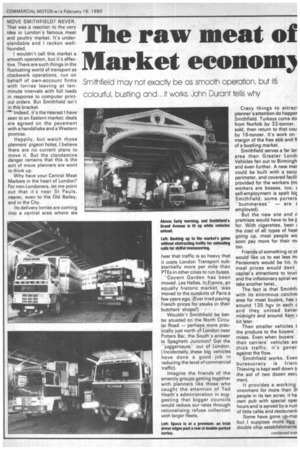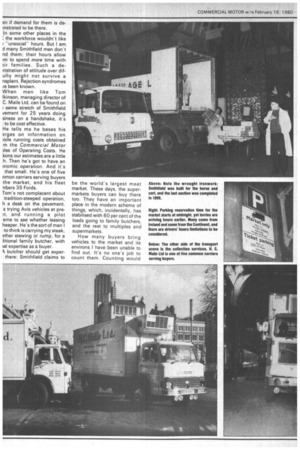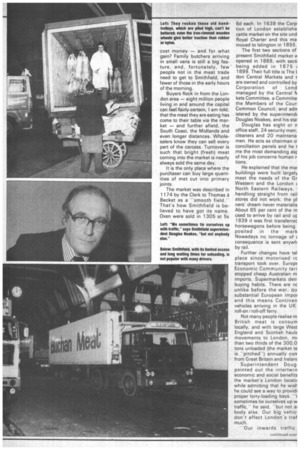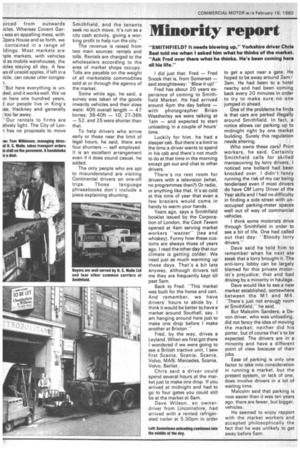The raw meat of Market economy
Page 51

Page 52

Page 53

Page 54

If you've noticed an error in this article please click here to report it so we can fix it.
Smi field may not exactly be as smooth operation, but it colourful, bustling and._ it worKs. John Durant tells why
MOVE SMITHFIELD? NEVER, That was a reaction to the very idea in London's famous meat and poultry market. It's understandable and I reckon wellfounded.
I wouldn't call this market a smooth operation, but it's effective. There are such things in the fluctuating world of transport as clockwork operations, run on behalf of own-account firms with lorries leaving at tenminute intervals with full loads in response to computer printout orders. But Smithfield isn't in this bracket.
Indeed, it's the nearest I have seen to an Eastern market; deals are agreed on the pavement with a handshake and a Western promise.
Happily, but watch those planners' pigeon holes, I believe there are no current plans to move it. But the clandestine danger remains that this is the sort of move planners are wont to think up.
Why have your Central Meat Markets in the heart of London? For non-Londoners, let me point out that it's near St PauIs, nearer, even to the Old Bailey, and in the City.
Its delivery lorries are coming into a central area where we hear that traffic is so heavy that it costs London Transport substantially more per mile than PTEs in other cities to run buses.
Covent Garden has been moved. Les Halles, in France, an equally historic market, was moved to the outskirts of Paris a few years ago. (Ever tried paying French prices for steaks in their butchers' shops?)
Wouldn't Smithfield be better situated on the North Circular Road —• perhaps more practically just north of London near Potters Bar, the South's answer to Spaghetti Junction? Get the -juggernautsout of London. ( Incidentally,these big vehicles have done a good job in reducing the level of commercial traffic).
Imagine the friends of the amenity groups getting together with planners like those who caught the attention of Ted Heath's administration in suggesting that bigger councils would reduce our rates through rationalising refuse collection with larger fleets. Crazy things to attraci planner's attention do happer Smithfield. Turkeys come do from Norfolk by 32-tonner, sold, then return to that cou by 16-tonner, It's work on margin of the free ebb and fl of a bustling market.
Smithfield serves a far lari area than Greater Londc Vehicles fan out to Birmingh and even further. A new mar could be built with a secu perimeter, and covered facili• provided for the workers (m; workers are bosses, too, E self-employment is spelt bic, Smithfield; some porters "bummarees" — are E employed).
But the new site and n premises would have to be p for. With cigarettes, beer E the cost of all types of heat going up, most people wo soon pay more for their MI too.
Friends of something or ot would like us to eat less rim Pensioners would be hit, hi meal prices would dent capital's attractions to touri and the inflationary spiral wc take another twist.
The fact is that Smith& with its enormous catchrn area for meat buyers, has c around 135 hgv in each c and they unload betwi midnight and around 4am c bit later.
Then smaller vehicles t the produce to the buyers' mises. Even when buyers' their carriers' vehicles art thick traffic, it's gener. against the flow.
Smithfield works. Even bureaucracy is frienc Thieving is kept well down ($. the aid of two dozen sect men).
It provides a working vironment for more than 31 people in its ten acres; it ha own pub with special ape' hours and is served by a nurr of little cafés and restaurant Some have gone up-mar but I suppose more egg double chip establishments en if demand for them is demstrated to be there.
In some other places in the : the workforce wouldn't like "unsocial" hours. But I am. d many Smithfield men don't nd them; their hours allow im to spend more time with
ir families. Such a deinstration of attitude over difulty might not survive a nsplant. Rejection syndromes ie been known.
When men like Tom lkinson, managing director of C. Maile Ltd, can be found on same stretch of Smithfield vement for 25 years doing siness on a handshake, it's to be cost effective.
He tells me he bases his 3rges on information on Ude running costs obtained m the Commercial Motor )Ies of Operating Costs. He kons our estimates are a little h. Then he's got to have an mornic operation. And it's that small. He's one of five nmon carriers serving buyers the market, and his fleet nbers 35 Fords.
Tom's not complacent about tradition-steeped operation, h a desk on the pavement.
s trying Avis vehicles at preit, and running a pilot eme to see whether leasing heaper. He's the sort of man I to think is carrying my steak, ether stewing or rump, for a iitional family butcher, with ial expertise as a buyer.
k butcher should get experthere: Smithfield claims to be the world's largest meat market. These days, the supermarkets buyers can buy there too. They have an important place in the modern scheme of things, which, incidentally, has stabilised with 60 per cent of the loads going to family butchers, and the rest to multiples and supermarkets.
How many buyers bring vehicles to the market and its environs I have been unable to find out. It's no one's job to count them. Counting would cost money — and for what gain? Family butchers arriving in small vans is still a big feature, and, fortunately, few people not in the meat trade need to get to Smithfield, and fewer of those in the early hours of the morning.
Buyers flock in from the London area — eight million people living in and around the capital can feel fairly certain, I am told, that the meat they are eating has come to their table via the market — and further afield, the South Coast, the Midlands and even longer distances. Wholesalers know they can sell every part of the carcass. Turnover is such that bright (fresh) meat coming into the market is nearly always sold the same day.
It is the only place where the purchaser can buy large quantities of met cut into primary joints.
The market was described in 1174 by the Clerk to Thomas a Becket as a "smooth field." That's how Smithfield is believed to have got its name. Oxen were sold in 1305 at 5s 6d each. In 1638 the Corp. tion of London establishe cattle market on the site und Royal Charter and this ma moved to Islington in 1855.
The first two sections of present Smithfield market vs opened in 1868, with secti being added in 1875 1899. Their full title is The don Central Markets and t are owned and controlled by Corporation of Lond managed by the Central kets Committee, a Committe the Members of the Cour Common Council, and adn istered by the superintend( Douglas Noakes, and his stal
Douglas has eight or n office staff, 24 security men, cleaners and 20 maintena men. He acts as chairman o. conciliation panels and he t me the most demanding as of his job concerns human r tions.
He explained that the mar buildings were built largely meet the needs of the Gr Western and the London North Eastern Eastern Railways, I handling straight from rail stores did not work; the pl ners' dream never materialis About 85 per cent of the m used to arrive by rail and ur 1939 it was first transferrec horsewagons before being posited in the mark Nowadays no tonnage of consequence is sent anywh by rail.
Further changes have tal place since motorised rc transport took over. Europe Economic Community tani stopped cheap Australian m imports. Supermarkets den' buying habits. There are nc unlike before the war, qu substantial European impor and this means Continen vehicles arriving in the UK roll-on/roll-off ferry.
Not many people realise m British meat is consum locally, and with large West England and Scottish haulz movements to London, m( than two thirds of the 300,0 tons unloaded (the market te is "'pitched-) annually corr from Great Britain and Irelan(
Superintendent Doug pointed out the intertwin economic and social benefits the market's London locatie while admitting that he wish he could see a way to providi proper lorry-loading bays. "A sometimes tie ourselves up w traffic,'" he said, "but not ai body else. Our big vehic' don't affect London's traf much.
"Our inwards traffic orced from outwards ides. Whereas Covent Gar! was an appalling mess, with Dpera House and so forth, we
contained in a range of ldings. Most markets are iple markets, with vehicles d as mobile warehouses, the 'idles staying all day. A few .es of unsold apples, if left in a Jicle, can cause utter conges-i.
"But here everything is unded, and it works.well. We've )n here one hundred years, our people live in King's )SS, Hackney and generally :too far away.
"Our rentals to firms are 3tively light, The City of Lon-I has no proposals to move
Smithfield, and the tenants seek no such move. It's run as a city cash activity, giving a working profit to help run the city."
The revenue is raised from two main sources: rentals and tolls. Rentals are charged to the wholesalers according to the area of market shops occupy. Tolls are payable on the weight of all marketable commodities sold at or through the agency of the market.
Some while ago, he said, a survey was taken of the goods inwards vehicles and their sizes were: 40ft overall length — 47 lorries; 36-40ft — 10; 27-36ft — 52; and 25 were shorter than that.
To help drivers who arrive early or those near the limit of legal hours, he said, there are four shunters — self employed. It is an excellent arrangement even if it does sound casual, he added.
The only people who are apt to misunderstand are visiting Continental drivers on one-off trips. Those language phrasehooks don't include a piece explaining shunting.
























































































































